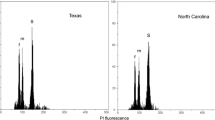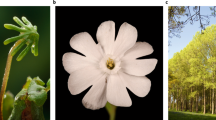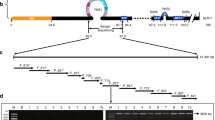Abstract
THE genus Rumex is divided by modern taxonomists1 in three sub-genera : Lapathum, Acetosa and Acetosella. In the sub-genus Lapathum only hermaphroditic species occur, but in the other two sub-genera diœcious forms are met. According to studies on the mechanism of sex determination met in these two latter sub-genera, the sub-genus Acetosella belongs to the Melandrium type of localization of sex-determining genes, that is, the Y possesses strong male elements, which may dominate over all the female elements in the X's and autosomes in the tetraploid, hexaploid and octoploid species of the subgenus2,3. The diœcious species of the sub-genus Acetosa, however, are found to belong to the Drosophila type of localization of sex-determining genes, that is, the Y's are inert, and the sex is determined by a balance between the X's and the autosome sets4,5,6. This latter mechanism prevents polyploidy, as shown by Bridges7, Muller8 and Ono4. The diœcious plants of the sub-genus Acetosa belong to the section Euacetosæ, but in the section Hastati polygamodiœcious and gynodiœcious species are met3. Hermaphroditic plants are met in other sections of the sub-genus, namely, Scutati and Vesicarii. Polyploidy has hitherto been known only within the British forms of the collective species R. scutatus9.
This is a preview of subscription content, access via your institution
Access options
Subscribe to this journal
Receive 51 print issues and online access
$199.00 per year
only $3.90 per issue
Buy this article
- Purchase on Springer Link
- Instant access to full article PDF
Prices may be subject to local taxes which are calculated during checkout
Similar content being viewed by others
References
Rechinger, K. H., Field Mus. Nat. Hist., Bot. Ser. 17, No. 1 (1937).
Löve, Á., Bot. Not., Lund (1941).
Löve, Á., Hereditas, 33 (1944), Diss. Lund (1943).
Ono, T., Sci. Rep. Tôhoko Imp. Univ., 4, 10 (1935).
Yamamoto, Y., Mem. Coll. Agric. Kyoto Imp. Univ., 43, 8 (1938).
Löve, Á., Hereditas, 28 (1942).
Bridges, C. B., "Sex and Internal Secretions", 2nd ed. (1939).
Muller, H., J. Amer. Nat., 59 (1925).
Fikry, M. A., J. Roy. Micro. Soc., 50, Ser. 3 (1930).
Ono, T., Jap. J. Genet., 16 (1940).
Author information
Authors and Affiliations
Rights and permissions
About this article
Cite this article
LÖVE, Á. Rumex Lunaria L., a Gynodiœcious Tetraploid Species. Nature 151, 559–560 (1943). https://doi.org/10.1038/151559b0
Issue Date:
DOI: https://doi.org/10.1038/151559b0
Comments
By submitting a comment you agree to abide by our Terms and Community Guidelines. If you find something abusive or that does not comply with our terms or guidelines please flag it as inappropriate.



